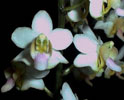|
|
|
|
|
| |
Flasks of
Phalaenopsis pulcherrima 'Houston' HCC/AOS × self |
|
| |
|
|
| |
| Number: |
TN2637 |
| Name: |
Phalaenopsis pulcherrima 'Houston' HCC/AOS × self
(Also commonly known as Doritis pulcherrima)
|
| Type: |
self (What's that?) |
|
Seed Donor: |
CJ Maciejeski
|
|
Click to Enlarge

Pod Parent Flowers |
|
|
|
| |
Culture Notes from Donor: Parent plant: Temperature range W (70-90°F)
Comments: Parent plant: 75 point HCC/AOS awarded 08/03/2001. Official AOS awards description: 95 flowers, 66 buds on three gracefully arching inflorescences, 2 branching. Petals, sepals creamy white, faintly suffused pale pink; lip pale lavender, midlobe white distally [I might make a note that the sidelobes are muted ochre yellow --CJM]; column green; all pastel colors clear & in pleasing combination. Substance firm, texture matte [Another note, it is slightly diamond dusted in sunlight --CJM]. Natural spread of flower 2.5cm horizontally, 3.1cm vertically; dorsal sepal 0.9cm wide, 1.4cm long; petal 0.8cm wide, 1.4cm long; lateral sepal 1.1cm wide, 1.0cm long; lip 0.7cm wide, 1.5cm long.
For additional origin/habitat information supplied courtesy of
Charles and Margaret Baker, see further below, near the bottom of this page.
|
Temperatures we attempt to use in the lab & greenhouse:
| For Species: |
|
Spring, Summer, Autumn: days average 88°F, nights 74°F; best fit is Warm 90-70°F
(Source:
Baker's Web OSC) |
| For Species: |
|
Winter: days average 85°F, nights 66°F; best fit is Warm-Intermediate 87-64°F
(Source:
Baker's Web OSC) |
| For Genus: |
|
Spring, Summer, Autumn, Winter: days average 87°F, nights 64°F; best fit is Warm-Intermediate 87-64°F
(
) |
|
About the name...
| Etymology of |
Phalaenopsis |
|
From Greek, "phalaina" moth; "-opsis" appearance.
(Source:
Pridgeon 1992) |
| Etymology of |
pulcherrima |
|
From Latin "pulcherrimus" very beautiful.
(Source:
Mayr & Schmucker 1998) |
| Pronunciation of |
Phalaenopsis |
|
fail-eh-NOP-sis
(Source:
Pridgeon 1992) |
| Pronunciation of |
Phalaenopsis |
|
fal-eye-NOP-sis
(Source:
Hawkes 1978) |
| Pronunciation of |
pulcherrima |
|
pul-KER-i-ma
(Source:
Hawkes 1978) |
|
If you would like to direct someone to this web page, please copy and paste this URL into your email:
http://troymeyers.com/d?012637
| Flask Information |
| Availability: |
Capsule failed. We were not able to make any flasks. |
| You should: |
Consider placing a "Notify Retries" Request, and if an identical pollination (the same parents) is done again, we'll let you know. |
|
You might also want to:
|
View items of the same species.
View items of the same genus.
|
| Ordering Information |
| You are not currently logged in. |
|
You must be a registered user and be logged in to reserve a flask or place a notification request. Please log in:
|
|
|
|
|
|
| |
The origin/habitat information below is supplied courtesy of Charles and Margaret Baker
The following information is based on the name of the plant provided by the donor, and assumes that the name is correct. If the plant has been misidentified, then the following information may not be correct.
This text is copyrighted by the Bakers and may not be reproduced without permission.
ORIGIN/HABITAT: Widespread from northeast India through Burma, Thailand,
Cambodia, Laos, and Vietnam, then southward through Malaya, Sumatra, and
Borneo. In Thailand, plants have been reported from all regions, except in
the vicinity of Bangkok. Plants are usually found at relatively low
elevations, but collections have been reported from as high as 4250 ft.
(1300 m). Plants generally grow as terrestrials in the shade of bushes and
shrubs. They are normally found in sandy, well-drained soil that contains
an accumulation of organic debris.
More about this information and the Bakers...
|
|
|
| |
|
|
|